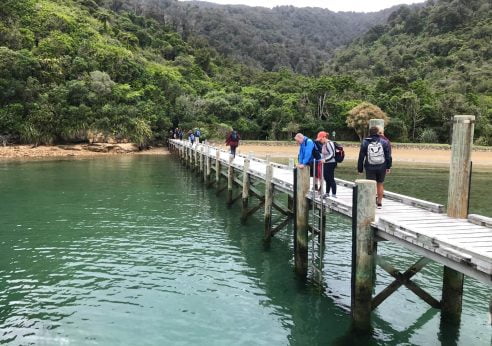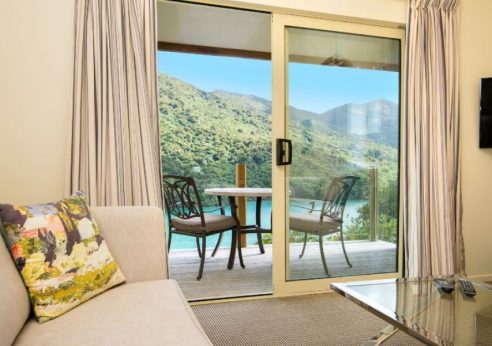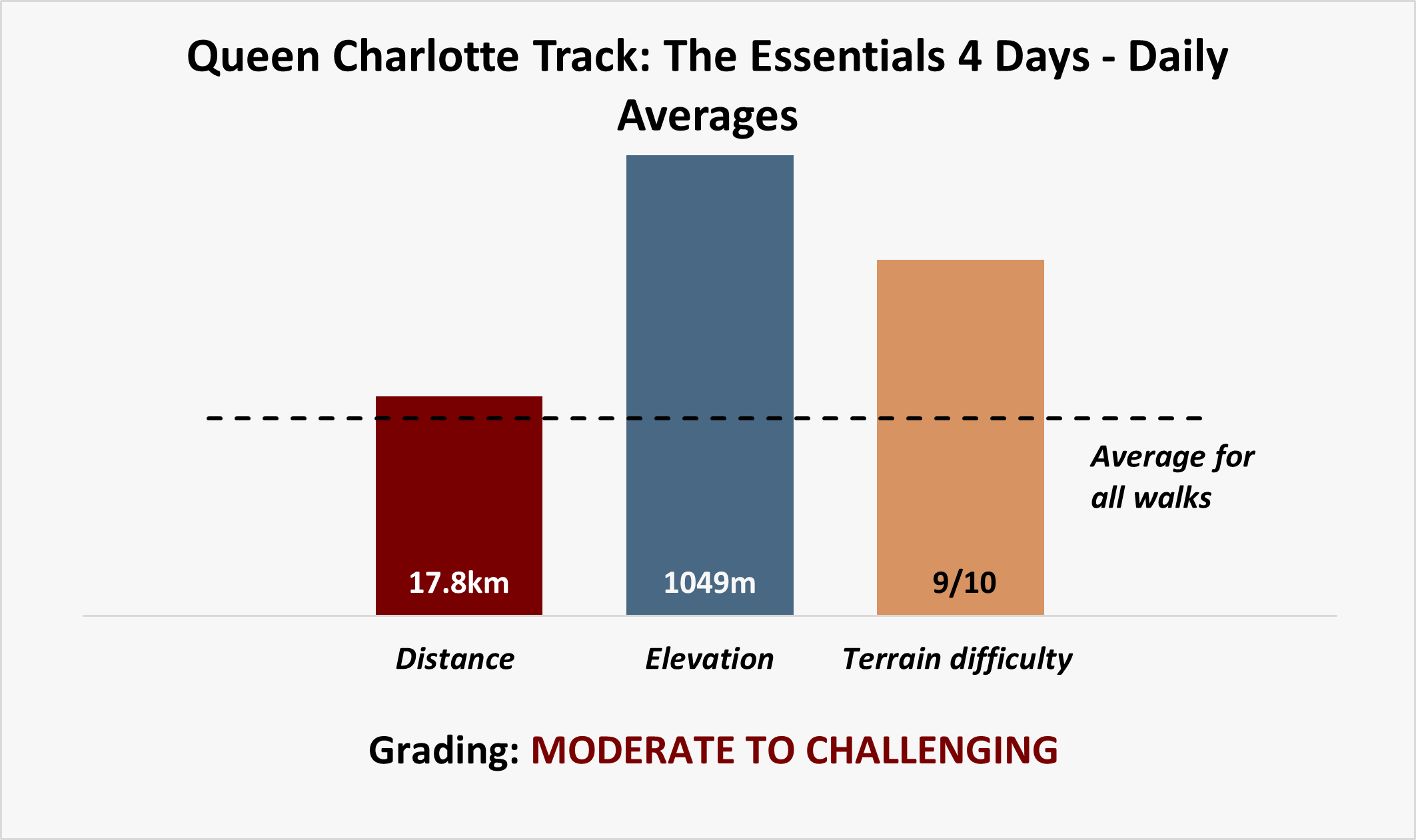FITNESS GUIDE
It’s well worth investing some time and effort preparing for your walking holiday. The graph shows the average daily distance, elevation and terrain difficulty for your hike. The dotted line indicates the average across all our walks, which will give you a feel for how challenging your walk is compared to all – and the recommended type, and amount, of preparation needed. Of course, you can adapt this according to your existing fitness levels and lifestyle.
The graph and the information below can be used in conjunction with the fitness guide to help you prepare for your walking adventure. Across all walks, average daily distance is 16.8km, average daily elevation is 448m, average terrain difficulty is 5/10.
DISTANCE - ABOVE AVERAGE
Distance training is a major consideration in your overall training program. As you progress, incorporate longer walks into your training plan.
Schedule one or two long walks each week, gradually increasing the distance until you can comfortably cover 17-25 km in a single day. Also include walks on consecutive days to help your body adapt to the demands of walking for multiple days in a row. Take every opportunity you can to walk. If you have a fitness watch or phone, you should try to reach >15,000 steps every day.
Ensure you can comfortably walk the average distance per day displayed in the graph, at least one month before you undertake your hike.
ELEVATION - ABOVE AVERAGE
Elevation training is a major consideration in your overall training program. You must include walks with serious hill climbs.
If you do not have access to hills, it is essential to replicate the elevation level you will be undertaking in any way possible such as on a treadmill or stair climber. Walking up and down stairs at work, at a local oval with a grandstand, or up and down small hills is incredibly useful. Also, prioritising resistance weight training will help you develop overall muscle strength. Elevation is often where walkers encounter problems, opposed to distance, as it uses an entirely different set of muscles to everyday flat walking.
If high altitude is a factor, incorporate sessions at a higher altitude to acclimatise your body to reduced oxygen levels if you are able to. Ensure you can comfortably walk the average elevation per day displayed in the graph, at least one month before you undertake your hike.
TERRAIN
MOUNTAINOUS / UNDULATING TERRAIN
As terrain associated with mountain climbs is often somewhat uneven and rocky, balancing and core exercises are vital.
Try to also include some form of elevation in more than 50% of your walking and prioritise resistance training, whilst incorporating stairs anytime you can. Walking up mountains or hills, up and down stairs at work, or up and down at a local oval with a grandstand is incredibly useful. Elevation is often where walkers encounter problems not distance, as it uses an entirely different set of muscles to everyday flat walking. Concentrate on doing lots of squats and lunges to build your glute muscles.
UNEVEN TERRAIN
Preparation for hiking on uneven terrain demands a blend of physical and mental readiness.
Begin with balance-enhancing exercises, such as one-legged stands and stability ball workouts, laying a groundwork for stability and coordination. Strengthening the lower body is especially important, achieved through the incorporation of squats, lunges, and step-ups. Gradually increase the complexity of the terrain on which you walk, moving from gravel paths to rocky trails. Cultivate mindfulness during your practice, directing focused attention to both your immediate surroundings and precise foot placement.
The importance of suitable footwear cannot be overstated; prioritise options that offer robust support and reliable grip to navigate varying terrains with confidence. Build endurance through consistent hikes, progressively increasing distance and difficulty.



 SELF GUIDED
SELF GUIDED 4 DAYS
4 DAYS
 Moderate to Challenging
Moderate to Challenging 




















Ann W
A selection of fabulous accommodation along a very beautiful trail. A treat.
Rowena S
This was a well organised walk from AusWalks. All the accommodation was excellent in both comfort and food aspects. The track was easy to follow and in good condition. The Portage offers free shuttle bus up to the start of the track on the last walking day. If you don’t take the shuttle you will add extra km of straight uphill to a bigger distance day. We enjoyed the walk and find AusWalks to be very reliable. Their app, maps and route guide all help to make their adventures safe and informative.
Alan M
A fantastic experience! 4 days of walking through absolutely stunning scenery with luxurious accommodation at the end of each day! Meals were great & while I was wary that the packed lunches might not be sufficient, I never touched one of the emergency muesli bars I packed! More than enough food across the whole trip. It was perfect & I was so euphoric when I finished the walk I could’ve started it again the next day! Thanks Auswalks – a brilliant experience!
Deirdre E
Queen Charlotte Track was stunning. Auswalk communication was clear and comprehensive. The accommodation and meals were excellent and welcome at the end of each day.
Amanda RI
All necessary information was provided by Auswalks in relation to departure for the start of the walk. The accommodation and food along the Queen Charlotte track itself was excellent.
Ronald T
The condition of the track was mainly very good, although it was quite slippery in some parts after the rain. The food was of very good quality. The entire went extremely well.
Derek W
Incredibly impressed with every aspect of the orgaisation from Auswalk. From prior to booking leading up to trip and all through the trip the organisation was excellent. Everything ran like clockwork and venues and inclusions exceeded our expectations. Will definitely book with Auswalk for our next walk and thoroughly recommend them to others.
Frank T
Access from the ferry was easy to the accommodation and the Beachcomber taxis. The whole walking experience was well organized.
Leevi E
We could not fault our Auswalk holiday! The accommodation, the friendly helpful staff, the food, the transfers, everything was seemless.This is my second walk with Auswalk and will certainly be booking another soon ?
Timothy M
All made very simple and clear. Very well put together.
Annie W
Entire trip went extremely well. Everything was straight forward to follow after exiting the boat. 71 years of age & Id definitely recommend the Queen Charlotte Track for all age groups
Deidre P
It honestly was seamless- I wouldn’t change a thing. Easy to understand directions on app and the luggage transfers worked great. Accommodation and food was fabulous!
Naomi F
Instructions were clear and the location of the first hotel to the start of the journey was short. The notes were excellent. Complete and articulate. The track was not too complicated though – well sign posted.
Julie F
Loved the Queen Charlotte Walk, with Auswalk. Very well organised, communication was excellent, the App is fabulous, physical maps were a bonus, accommodation was beautiful. All in all a great trip!
Adrian K
We’ve walked with AUSWALK in Europe, Japan, Australia and now NZ. They have always been great. The Queen Charlotte Track would be up there with our favourites. Definitely not to be missed – scenery, track conditions, accommodation, food, everything. Do it!
Rob F
Auswalks organisation was exemplary! My wife and I have walked in a variety of countries around the world with various walking companies and we both agreed that their organisation was the best we have experienced!! Well done to the team!!! Accommodation, food and materials were all top notch!! ?
Bernard B
The notes provided were very comprehensive. The Universal Hikes app was excellent especially to track your progress during the day. The accommodations are convenient, easy walk to water taxi.
Tanya M
The walking notes were great and very comprehensive. The app was also great to see where you were which made the entire trip extremely well.
John G
Great walk. Outstanding accommodation and meals.
Jennifer T
Fabulous self guided walk on the Queen Charlotte track, expertly supported by Auswalk. Detailed information provided and all plans worked seamlessly.Great accommodation and food.
Nicole B
My friend and I enjoyed every aspect of our Auswalk tour. All arrangements were seamless, the accommodation, meals, transfer our our luggage all went without a hitch. The walk itself was stunningly beautiful and most uncrowded.
Richard L
We found the entire process seamless and trouble-free with Auswalk. There were no unexpected problems and everything went like clockwork. I strongly recommend them!
Karen T
Very well organised a fantastic trip
Kristy M
We are a group of 7 x ‘60 something’s’ from South Australia. Our Queen Charlotte walk went seamlessly. We sat down after the walk and tried to come up with something that could be improved. But we couldn’t think of anything! The accommodation was all excellent, the food for breakfast, lunch and dinner was delicious, the staff at the various accommodations were very friendly and helpful. The trip was planned well and all details were documented well, by email, in hard copy and on the app. We would highly recommend Auswalk to anyone wanting a well planned and executed walking trip.
Richard G
Auswalk provided a great walking experience for us, the accommodation and food provided along the track was exceptional and we would highly recommend anyone thinking of doing the Queen Charlotte track to use Auswalk.
Nathan W
Strongly recommend that this walk is ALSO offered as a 2-night stay at each section, to allow a slower enjoyment of the area and lovely resorts. Walk one day, then relax the next. Walk the section section on the day after, etc.
Maria C
This walk exceeded my expectations. The accommodations and the included meals were wonderful. Auswalk provided good notes, the App was helpful and any queries were answered promptly. Highly recommend this walk and Auswalk.
Shani P
The walking days were fantastic. Furneaux lodge and Punga Cove were excellent accommodation choices – rooms, food, service and location were all brilliant. Walking notes were great too, thank you.
Mark A
It was a very enjoyable walk with lovely scenery, vegetation and a good track. The bag transports were excellent and the accommodation was very good.
Patricia B
The accommodation was wonderful after a hard day. Food at every venue was superb. All the staff went out of their way to accommodate our needs., absolutely amazing. I thought the whole trip was wonderful and I’m a first time hiker! The weather was great! Lucky for us.
Mike B
The coordination exceed my expectations really. I can’t fault the program. Everything from checking on the first night to a very early exist on the last day to return to Wellington and fly home to Australia went well across the 4 hotel accommodation facilities utilised. The transfer of back packs worked very well as per the planned itinerary.The food and service at the hotels were outstanding. Accommodation very good quality.The lunch packs were great and just right.This was my first time using Auswalk and couldn’t fault the itinerary. Beautiful cool hiking weather, amazing scenery, and terrific services to finish an exhausting day hiking.
Kerry M
We were in Nelson at the end of the Abel Tasman Walk and a transfer was arranged with Sarahs Transfers to take our group to Picton to start the walk. It was seamless and Sarah was lovely. We enjoyed all aspects of the walk.
Lorrae A
Our trip went extremely well. Everything went smoothly and the accommodation was 5 minutes walk.
Cathy L
The entire process was very convenient. The directions on where to go were great. Our trip was excellent overall.
Chris McLa
The track unfolds with stunning variety in the landscape and sights, at the end of the day theres beautiful accommodation and food.
Merrin M
This was a beautiful walk. A couple of longish days but no very steep climbs. Nicely paced for a reasonably fit walker.All the arrangements were seamless. Another excellent Auswalk experience!
Ruth D
Our trip went extremely well. The dept point was very easy and the track was easy to follow. Would love to try all of the other destinations too.